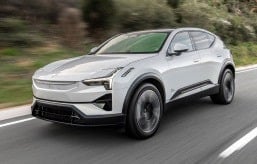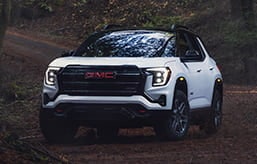- We put a Tesla Cybertruck Foundation Series up against two of our long-term testers: the Ford F-150 Lightning and Rivian R1T.
- The Cybertruck is certainly the most polarizing of the bunch, but we'll examine how it functions as a daily driver and cargo-hauler.
- Which truck wins? Read on (and watch the video) to find out.
Tesla Cybertruck vs. Ford F-150 Lightning vs. Rivian R1T: The Long-Awaited EV Truck Battle
Here's how the infamous Cybertruck compares to its key electric rivals
Here we have the new Tesla Cybertruck, a vehicle that we're not going to kick, we're not going to shoot and we're not going to declare an act of god as we wave our hands around in an excitable fashion. Instead, we're going to see what this radical and polarizing pickup truck is like as a, well, a vehicle. Is the Cybertruck really a seismic breakthrough — a Tesla Model 3 for the truck market?
To find out, we're going to put the Cybertruck up against electric pickups that cost similar money: the Ford F-150 Lightning and Rivian R1T, both of which come right from Edmunds' own long-term test fleet. We'll analyze their beds, talk about interior comfort and subject them to our world-famous EV Range Test. Will one truck reign supreme over the others?
By the numbers
The Ford F-150 Lightning comes with a 131-kWh lithium-ion battery — assuming you go for the Extended Range option like we did — and a pair of electric motors. Total output is a healthy 580 horsepower and 775 lb-ft of torque. In our instrumented testing, the F-150 weighed in at 6,745 pounds but was still powerful enough to rip off a 0-to-60-mph time of 4.3 seconds.
Meanwhile, our Rivian R1T is the original Launch Edition, which comes with the 135-kWh battery pack and four(!) electric motors, delivering 835 hp and 908 lb-ft of torque. All this force allows the R1T to run the 0-to-60 sprint in a scant 3.5 seconds — and that's despite this all-wheel-drive pickup truck tipping our scales at 7,148 pounds. Woof.
Now, before ye Tesla faithful point out that the upcoming Cybertruck Cyberbeast tops all those numbers, that model isn't yet for sale. The specs of our Foundation Series tester are also oddly hard to verify, but it has around 600 hp and can hit 60 mph in 3.9 seconds. Because the truck we borrowed belonged to a private owner (Tesla does not maintain a press fleet — or a public relations department, for that matter), we couldn't put it through our full instrumented testing regimen. But here's an interesting tidbit: When we rolled it onto our scales, the Cybertruck weighed in at 6,653 pounds, making it the lightest truck here.
How do they drive?
The Cybertruck drives quite nicely; the ride quality is good, it's quick, and your brain easily adjusts to the variable-ratio steering (and the yoke). It's not as truck-like as its rivals, which may or may not be a good thing depending on your personal tastes. We do, however, wish so many of the driving functions weren't housed in the central screen, which is often tricky to use. The voice commands are finicky, too.
The F-150 is certainly the most truck-like of the bunch — albeit still rather quick. It's a lot rougher than the Tesla, and indeed, rougher than the Rivian. The R1T's slightly smaller size and adaptive air suspension suit the truck's daily driving duties well, but goodness these all-terrain tires are loud. It's a complaint many folks on our staff have had with the long-term tester ever since we bought it.
Range tested
We've put all three of these trucks through our standardized Edmunds EV Range Test and, well, picking a winner largely depends on which version of the truck you buy.
This Foundation Series Cybertruck doesn't have an EPA rating — in fact, it doesn't even have a rating on Tesla's consumer website — but early reports suggested a manufacturer-estimated claim of 318 miles. We saw 334 miles during our range test, which is great, especially since no other Tesla to date has met or exceeded its EPA estimates in our testing.
We've put a few versions of the Ford F-150 Lightning and Rivian R1T through the Edmunds EV Range Test, and again, the numbers differ based on trim level. We tested a 2023 Ford F-150 Lightning Lariat and saw 345 miles, while our 2022 Ford F-150 Lightning Platinum Extended Range long-termer achieved 332 miles. A 2022 Ford F-150 Lightning Pro did 265 miles.
Rivian? Well, its truck performed the best. The 2023 R1T Performance Dual-Motor on 21-inch wheels went 390 miles in our test. However, our quad-motor Launch Edition only went 321 miles. Four motors definitely affect range.
No matter how you slice it, the dual-motor Cybertruck is competitive, and Tesla says its longest-range truck will do 340 miles on a full charge. We'll see about that.
Interior refinement and tech
The first thing you notice when you sit in the Cybertruck is the sheer depth of the dashboard. It strangely messes with your overall depth perception — especially since you can't see the hood.
Overall, the Cybertruck's seats are OK, but they lack support under your thigh. There's decent storage, a really impressive audio system and the back seats are pretty good, too. There's lots of legroom for adults, and you'd have to be quite tall to run out of headroom. However, if you are a bit tall, you'll surely bang your head against the hard support beam for the glass roof. Be careful.
The thing we hate more than anything, though, is Tesla's over-reliance on the central infotainment screen for pretty much all of the Cybertruck's controls. We'd love a screen in front of us for things like the speed and blind-spot monitoring, and the rearview camera is all but useless with the tonneau cover closed, at which point you have to rely on a backup camera ... in the screen.
The Ford F-150 Lightning also has a big screen, supplemented by another smaller display in front of the driver and plenty of old-school buttons. It’s generally intuitive to use and this is the only truck here to offer Apple CarPlay and Android Auto smartphone integration. Ford really understands truck buyers and offers some really clever touches. There’s loads of storage, we love the fold-out table for working or eating, and the seats recline to form a makeshift bed. Like job-site naps? This is your truck.
Rivian, like Tesla, has developed its own software solutions, which have gotten better and better the longer we’ve owned our long-term R1T. The overall impression of quality is good and there are some startup carmaker novelties, such as the integrated Bluetooth speaker and flashlight. For great rear seats you have to give it to the Rivian, with their lovely padding and support. It’s just too bad this truck has the smallest seating area of the three pickups tested here.
Truck stuff
These trucks' towing specs are pretty comparable; as tested, the Cybertruck and Rivian can pull 11,000 pounds, while the F-150 Lightning can handle 10,000. Of course, when we've done towing tests with the Ford and Rivian, driving range has been heavily impacted. We expect the Cybertruck to have the same issue. It's just part of doing truck stuff.
The Cybertruck has the longest bed of the bunch, but the unconventional shape of the truck's sides makes it hard to use. Some of the tie-downs are hard to reach, and the sides are hard to reach over — even for taller folks.
The Ford and Rivian have more conventionally shaped beds, and while they might be shorter, they're loads easier to use. The Rivian also has an extra ace up its sleeve: the gear tunnel that runs the width of the truck, offering secure storage between the cab and the rear axle. The little doors can even be used as seats when they're open. Neat!
In the video above, we demonstrate the various ways these trucks can haul different types of cargo. How different are they, really? Honestly, not all that much.
Tesla vs. Ford vs. Rivian: Which EV truck is best?
Look, the Tesla Cybertruck won't do for electric pickup trucks what the Tesla Model 3 did for electric cars. It's simply not versatile enough, not clever enough and it's way too expensive.
As a lifestyle commodity, the Rivian R1T might be less eccentric and less spacious, but it's much easier to use and live with day to day. As a work-ready pickup truck, the F-150 checks all the right boxes, and it'll have formidable competition with the Chevy Silverado EV and Ram 1500 Rev in the coming year.
Moreover, it's worth reminding that we've named the Ford F-150 Lightning our Edmunds Top Rated pickup truck for the past two years running. It's still the one we'd have over all the others — but who knows, maybe putting a Cybertruck through our full testing regimen will change our minds.
In the end, the Cybertruck is a passion play; Tesla built this thing because it wanted to, and we have to salute that. Yes, we have some reservations about how the stainless steel will age, the truck's immense width makes it challenging to drive, and there are clearly a lot of areas where function follows form. That said, the Cybertruck is actually quite usable and genuinely good to drive. And it definitely turns heads — more so than pretty much anything out on the road today.
Edmunds says
If you want a work truck, get the Ford. If you want a lifestyle truck, get the Rivian. And if you want a Cybertruck, well, get a Cybertruck. It's really as simple as that.








 by
by  edited by
edited by